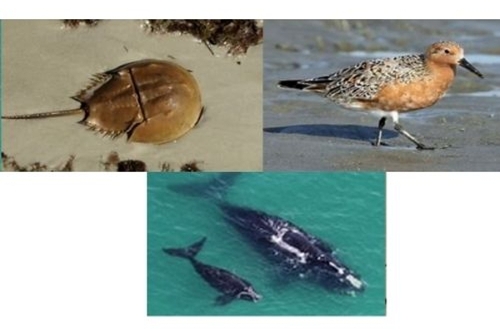
Feds Approve "Environmental Disaster"
off our Coast for Earth Day
Director of Center for Energy & Environmental Policy
April 19, 2021 (last updated April 20, 2021)
It is time to know the truth about what an "environmental disaster" will look like if we build thousands of skyscraper-sized wind turbines off every major coastal beach from Massachusetts to North Carolina.
Creatures from the lowly horseshoe crab to the majestic whale are threatened. Visual blight threatens tourism. COVID-19 showed how fragile our beach economy is with lost income for employees and hospitality business owners.
Concerned citizens can gather with us on the beach at the Delaware Seashore State Park, just south of the Indian River Inlet Bridge, for an "Earth Day" watch at 10:00 AM on Thursday, April 22nd. Stopping this disaster will require expensive David vs. Goliath legal action, and you can help with an online or check donation.
The existing Atlantic coastal habitat consists of a seafloor of constantly shifting sand offering shelter to burrowing animals. An unobstructed ocean is now filled with free-swimming fish and mammals, and the unobstructed air is filled with migrating birds.
An ocean filled with wind turbines as tall as the Chrysler Building in Manhattan threatens birds. Acres of cement and rock will be laid to prevent scouring of the sand that supports these monster wind turbines. New sounds from moving wind turbines and electromagnetic fields will fill the sea and air.
No adequate environmental studies explore the impact of these changes on the myriad animal life in the ocean environment.
Here are three key examples:
- There are only 356 Northern Right Whales left, and they regularly visit the proposed wind lease areas. The loss of a single Northern Right Whale could be catastrophic. Recent accidental deaths were caused by vessel strikes, entanglements, and ocean noise, all of which will be worsened by offshore wind projects.
- Horseshoe crab blood is the only known substance used in testing for endotoxins. COVID-19 vaccines cannot be administered without it. The crabs burrow into the sandy seafloor to hibernate for the winter, primarily in a federal reserve off the New Jersey, Delaware, and Maryland coasts. Proposed Skipjack, Marwin, and Ocean Wind projects and their cables would sit on top of the reserve.
- Migrating birds, like the endangered Red Knot, will be endangered by both the whirling wind turbine blades sweeping an area of 8.5 football fields each and from the possible loss of a critical food source of horseshoe crab eggs laid on the beach.
This federal plan to spend $100 billion on offshore wind investment will have minimal impact on climate change and cost three to four times more than onshore wind or solar power. The offshore projects will only add 3% of unneeded generation capacity to the US electric grid.
No existing generators can be closed because they will be needed for backup when the wind doesn't blow. Operating coal and natural gas-fired power plants as backup generators add inefficiencies that lead to more pollution. At best global temperatures will be reduced to 0.02° C by 2100 if all the proposed projects are built.
President Biden is likely to announce on "Earth Day" the approval of the precedent-setting "Vineyard Wind" project near scenic Martha's Vineyard and Nantucket, MA. The decision opens the floodgates for 450 skyscraper-sized industrial wind turbines that will be 14 miles off the island's coast extending for 90 miles by 30 miles deep tract.
The approval comes despite finding the project will have a major negative impact on the fishing industry and scientific research important to food security, vessel safety, radar, and Coast Guard search and rescue operations.
The U.S. Department of Interior (DOI) spent three and a half years studying the proposed "Vineyard Wind" project. In December, the Department's solicitor determined, based on existing law, that the Secretary of the DOI had a duty to deny the "Vineyard Wind" project as it would forever interfere with the historic rights to unobstructed fishing and ocean views.
However, the new Administration is reversing the finding after only seven weeks by cobbling together a slightly revised "alternative" from six "alternatives" already studied.
At the very least, the new "alternative" should have re-opened a required year-long review period.
|
|
|
|
|
|
|
